Sitting down with the Director
Artistic Director Sean Murray shares his thoughts on our upcoming Sam Shepard shows – Fool for Love & True West
Cygnet is continuing it’s tradition of plays performed in rotating repertory. What’s different about this rep?
This season we are focusing exclusively on the work of a single playwright. Each play stands on its own and you don’t need to see one to appreciate the other. However, when you are able to experience these two different plays side-by-side, one begins to recognize common themes between them. Both plays explore a crisis of identity and betrayal. Characters in both shows experience an existential soul searching and a feeling that their lives are inauthentic. They also are pretty funny people as they grapple with essential issues such as disconnection, empty searching and a deep sense of betrayal.
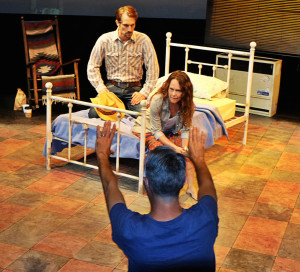
When did you first become aware of Sam Shepard’s work?
I first became aware of Shepard’s work in the early 80s when I worked as an actor for the San Diego Repertory Theatre. At an early age, I was cast as Crow, the punk-rock-pirate from The Tooth of Crime. I worked there when they presented the San Diego premieres of True West and Fool for Love, again in the early 80s. Additionally, while I was in school at the North Carolina School of the Arts, I played Weston in Curse of the Starving Class, a show I later produced at Cygnet Theatre.
What are the challenges you face when staging True West?

On a purely technical level, the script has the two brothers literally destroy the suburban kitchen that is the set. We have fifteen toasters, that all have to make real toast, a typewriter that is literally pounded into pulp by a golf club wielding character, the contents of kitchen cabinets thrown across the floor, a wall-phone that become a weapon after it is torn from the wall! The actual aftermath of all of this chaos has to be carefully considered.
The acting challenges are also vast. Each character goes on an existential journey from the quiet, tension-filled first scene to the all out chaotic war of the final scene. Pacing this progression is important. Finding the way into the levels of envy, threat and betrayal that these characters must portray is a frightening and exciting process for the actors.

Fool for Love is both arduous and physically challenging. What’s your take on this play?
The biggest challenge we’ve experienced in getting into the depths of Fool for Love has been in determining what is true and what isn’t. The characters accuse each other of lying throughout the play. There is a layering in this play that conceals the actual truth that they are running from. Like Austin in True West, May is attempting to recreate herself anew. She is trying to escape what she was and forge a new self. The sudden reappearance of Eddie, like the reappearance of Lee in True West, forces a confrontation between one who wants to hold the other to who they have been, and the other who is trying to break with their past. As we explore what is actually happening between these characters, and we continue to raise their stakes in the play, that informs the level and veracity of the physical actions.
Can you share some of your thoughts about deciding to take on these plays?
These two particular plays are rooted in a sort of realism. I say “sort of” because on the surface they take place in a kitchen or a motel. There are real props, etc. The character dialogue sounds like a realistic conversation on the surface. However, there is a very strong poetic quality to the language and imagery. Finding actors who can develop these characters to the marrow and handle the heightened poetic language is not always easy. In addition, when you are trying to cast actors who have to also be ‘right’ for not just one role but two different roles, this adds a new challenge.
Don’t miss Fool for Love and True West Sept. 24 – Nov.2.
7 Things to Know: Fool for Love & True West
As part of our goal to help you understand the thought-provoking work of American playwright and icon Sam Shepard, we’ve put together 7 things you should know about Fool for Love and True West. If you don’t already, follow us on Facebook for daily “fun facts” about Sam Shepard, the plays, as well as behind-the-scenes info and pictures.
3 things worth knowing about Sam Shepard’s Fool For Love:
-First performed at the Magic Theatre in San Francisco on February 8th 1983 with Kathy Baker as May and Ed Harris as Eddie.
-It was nominated for the Pulitzer Prize for Drama in 1984.
-The play was turned into a movie in 1985, for which Sam Shepard also wrote the screenplay and starred as Eddie opposite Kim Basinger as May.
4 things worth knowing about Sam Shepard’s True West:
-First performed at the Magic Theatre in San Francisco on July 10, 1980.
-It was nominated for the Pulitzer Prize for Drama in 1983.
-It was nominated in 2000 for the Tony Award for Best Play.
-The play was turned into a made-for-TV-movie in 2002, which starred Bruce Willis and Chad Smith.

Inside the 4-Color Way
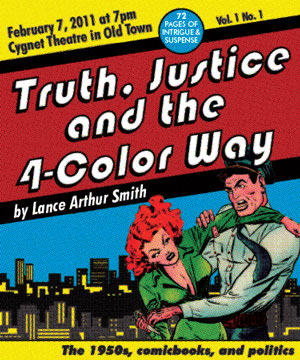 We asked playwright Lance Arthur Smith a couple of questions regarding his new play Truth, Justice and the 4-Color Way, which will be presented as a staged reading as part of Cygnet’s Playwrights in Process Series.
We asked playwright Lance Arthur Smith a couple of questions regarding his new play Truth, Justice and the 4-Color Way, which will be presented as a staged reading as part of Cygnet’s Playwrights in Process Series.
Cygnet: What was the inspiration for Truth, Justice and the 4-Color Way?
Lance Arthur Smith: I originally conceived of this piece in early 2008 after learning my wife Colleen was pregnant. The 1954 Senate Subcommittee hearings have been on my radar for years due to my love of comic books. But with my daughter Scotland on the way, I felt compelled to explore parental themes in a play, and the backdrop of this 1950s comic book “war” felt like the right way to do it.
It focuses on an oft-overlooked event in our country’s history as well as on the major personalities surrounding it. The parallels to today’s video game industry, and the Hollywood machine, strike me as I figure out where I stand as a father.
Cygnet: What it means to have your play workshopped at Cygnet.
Lance Arthur Smith: Cygnet’s “Playwrights in Process” fosters playwrights in a program that, sadly, exists in very few places. Many theatre companies say they make a commitment to new work, but Cygnet commits itself fully to cultivating new work through a series of readings and interactions.
Fran championed this piece, and to have his backing and support has been a refreshing experience. Both he and Sean have been actively involved throughout several rewrites, and we’ve had meetings outside of rehearsal halls, through email, and over dropped phone calls (thanks to my unreliable carrier).
Joining a playwright the caliber of Stephen Metcalfe (whose Tragedy of the Commons was refined during “Playwrights in Process”), is a joy and I’m looking forward to continuing the theatrical conversation of 4-Color Way with a live audience.
Meet Stephen Metcalfe
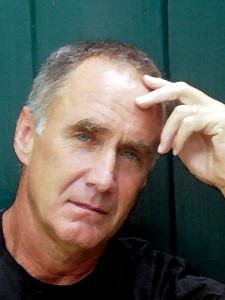 In January 2011, Cygnet Theatre will have the honor of producing its very first World Premiere – The Tragedy of the Commons, by celebrity playwright Stephen Metcalfe.
In January 2011, Cygnet Theatre will have the honor of producing its very first World Premiere – The Tragedy of the Commons, by celebrity playwright Stephen Metcalfe.
Stephen Metcalfe, a nationally renowned stage writer, is possibly most recognized for such Hollywood blockbusters as Pretty Woman (with Julia Roberts and Richard Gere) and Mr. Holland’s Opus (with Richard Dreyfuss).
CT: Did you start out writing for film?
SM: I started out as a playwright. Between 1978 and 1985 I wrote five full length plays and perhaps half a dozen one act plays. Even though all the work was produced, I was in no way, shape or form making a living from it. At one point I thought it might be a relief to go into advertising.
CT: What are some of the differences between writing for film versus the stage?
SM: I discovered early on how difficult plot can be. In the theatre, plot is an excuse for people to talk. In a movie, it’s a reason for them to blow things up. Here’s another difference. If a play is a house, others can decorate, but they can’t tear down the walls. It’s yours, you own it. If a screenplay is a house, people can tear it down to the foundation, dig a deep hole and throw away the key. They own it. (This doesn’t mean that sometimes you don’t get the credit – or blame – for what they did.)
In the theatre no one is asking you to be a playwright – in fact, if pressed, they’d probably tell you to go into advertising – but if you write a play, they’ll read it. In film, no one reads anything. But if they hear you’ve done something that’s pretty good, they’ll pay you to do something else.
CT: What impact did your success with Pretty Woman have on your career as a writer?
SM: For better or for worse, in 1991 I wrote the production draft of the screenplay for Pretty Woman. And so for the next ten years the phone rang pretty much on a weekly basis with someone – who, as mentioned, had usually never read my work – asking me to re-write a romantic comedy. The problem was I didn’t consider myself a writer of romantic comedies. But as I was trying to do silly things like pay a mortgage and raise a family, as often as not I’d take the job. But in between re-writing romantic comedies I continued to write my own screenplays on spec. This, to some extent, took the place of my writing for the theatre. It felt the same. My own screenplays I hoped/felt were character and dialogue driven and were emotionally grounded; they felt to me as if they were about real things. Of course, they didn’t have a snowball’s chance in hell of getting made.
CT: What prompted you to begin writing for the stage again?
SM: In 2005 I had a growing realization that though I’ve made a living as writer, the best work I’ve done is probably sitting on shelves in LA somewhere. Did I mention that a dramatist writes for actors and an audience? The writing is not the end unto itself, seeing it done is. And so, with this in mind, the desire to see work done, I find myself writing plays again. I have no fantasies I’ll make a living doing it but that’s okay. I’m also going into advertising.
How I Conquered Norman…
(One Woman’s Journey into an Oversized T-Shirt.)
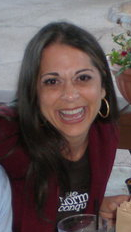 I’ll admit it…When it comes to fashion; I’m a girly-girl. Almost everyone who knows me has ultimately asked me if I OWN a shoe without a heel. Skirts and sundresses are my summer uniform and a day without earrings is a day spent tugging naked earlobes. So my brown “i conquered norman” t-shirt was something of an anomaly to me on the morning of Cygnet’s THE NORMAN CONQUESTS All-Day Opening Extravaganza. Three full-length plays taken-in with a theatre full of audience members I’d known or met through the years and nary a piece of clothing in my closet to match that ringspun cotton crew-neck.
I’ll admit it…When it comes to fashion; I’m a girly-girl. Almost everyone who knows me has ultimately asked me if I OWN a shoe without a heel. Skirts and sundresses are my summer uniform and a day without earrings is a day spent tugging naked earlobes. So my brown “i conquered norman” t-shirt was something of an anomaly to me on the morning of Cygnet’s THE NORMAN CONQUESTS All-Day Opening Extravaganza. Three full-length plays taken-in with a theatre full of audience members I’d known or met through the years and nary a piece of clothing in my closet to match that ringspun cotton crew-neck.
Noon-time found me anxiously awaiting the first CONQUEST of the day…Round and Round the Garden. I admire every one of those gorgeous actors, (not to mention both of the gifted directors and all of the amazing designers and crew) and I am an Alan Ayckbourn fanatic. There was so much talent ready to bring the story of the “quirky assistant librarian” and his “oddball in-laws” to life. I tapped my foot nervously – my foot, donned in a suede knee-high boot picked to match my jeans, jewel-encrusted belt and a thin-belted, rich red sweater… (My Norman t-shirt peeked out in protest.) Well, at least our new Cygnet logo was visible. It matched my sweater perfectly. And I WAS wearing the t-shirt…my show-support evident, if anyone was inclined to check. Continue reading
Cygnet’s 8th Season!
We are delighted to announce our 2010/2011 line-up. Our eighth season will offer productions ranging from a world renowned classic to a world premiere and kicking it all off will be something never before done at Cygnet Theatre – a trilogy of connected plays performed in repertory!
To start the season, we will revisit the works of Alan Ayckbourn, author of our immensely popular production of Communicating Doors. This time instead of traveling through time, we will visit the same time as seen in three different rooms, all of which get their own play! The Norman Conquests – which includes Table Manners, Round and Round the Garden and Living Together – revolve around Norman a charming library assistant, and the women in his life. Each play stands on its own, however, the fun is in seeing the entire trilogy as each play reveals unique secrets, surprising answers and loads of laughs. Directed by Artistic Director Sean Murray and Francis Gercke, The Norman Conquests will run in rep with the same six actors from July 28th through November 2nd, 2010.
Postage Stamp Style
 My mother is an art teacher. She’s been teaching since I was 13 years old. She used to tell me that she was surprised to find she never ran out of new ideas for lessons. She always thought the day would come when she’d need a lesson on Van Gogh or Matisse and…nothing… No ideas. Blank slate. But that day never came. She said that was the beauty of art and creativity. It’s endless.
My mother is an art teacher. She’s been teaching since I was 13 years old. She used to tell me that she was surprised to find she never ran out of new ideas for lessons. She always thought the day would come when she’d need a lesson on Van Gogh or Matisse and…nothing… No ideas. Blank slate. But that day never came. She said that was the beauty of art and creativity. It’s endless.
On costuming modern day shows… Sean Murray seems to think I have a pretty good eye for dressing people in current fashions and has honored me with the title of costume designer for three Cygnet shows – all taking place in present day. But the innate difficulty of costuming a show that doesn’t depend on a historical time period for colorful expressions of the day is that – if you do it well – it will very often go unnoticed. And let’s face it… no artist (of any sort) wants their work to go unrecognized.
any sort) wants their work to go unrecognized.
To deal with this, I approach each show with a secret concept…something I’m pretty sure the audience won’t pick up on but satisfies me none-the-less. In Dying City I allowed the Iraq War to exist, not only as the background for the play, but on the stage within the costumes; the war between the characters playing themselves out in Peter and Craig’s all-American dress and Kelly’s subtly Middle Eastern-feeling fabrics, colors and jewelry. In Love Song, Beane requests “a rainbow” as a birthday gift, and upon his discovery of his new love Molly, the grays in the costumes dissipated into brilliant hues – even and especially in Joan and Harry’s apartment.
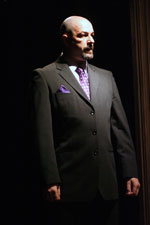 So when it came time to costume Mauritius, I began my musings for my special secret concept. I read the play. I read it four more times… Nothing. I went on-line and perused everything I could find about stamp-collecting, looking for the hook. Zippo. I thought about my mother. Where was that endless creativity? Maybe there was an artistic limit. Apparently my max for Cygnet was two shows. The gig was up.
So when it came time to costume Mauritius, I began my musings for my special secret concept. I read the play. I read it four more times… Nothing. I went on-line and perused everything I could find about stamp-collecting, looking for the hook. Zippo. I thought about my mother. Where was that endless creativity? Maybe there was an artistic limit. Apparently my max for Cygnet was two shows. The gig was up.
Finally…I admit it… I went on-line to look at the Broadway production photos. Then, other production photos. I felt uninspired. They were all the same. Dennis donned in a sleazy leather jacket. Jackie attired in the 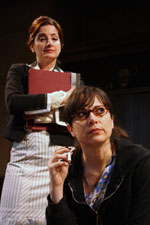 apparently requisite jeans and a hoodie. Mary bequeathed with the unflattering matronly threads of a spinster. Where was the whimsy? Worse… Why the stereo-types? This was a play submersed in cons and trickery, after all.
apparently requisite jeans and a hoodie. Mary bequeathed with the unflattering matronly threads of a spinster. Where was the whimsy? Worse… Why the stereo-types? This was a play submersed in cons and trickery, after all.
My inspiration came mid-conversation. Anytime I mentioned Mauritius to a friend, their response was the same. “Stamp collecting? Does anyone even do that anymore?” They imagined a production rife with antiquated lessons on the creation of the postal system. The delightful irony of the Quentin Tarentino-esque ride our audiences will take amused me. But then, there it was! These characters ARE submersed in a world of vintage collections. They are the world’s most obsessed tiny-art collectors. They LOVE the beauty of a bygone era. And they are suckers for the most intimate details.
 I began my search for modern-day clothes with a vintage-feel. Aside from Jackie, who discovers the crazy under-belly trade as the play progresses, the other characters seemed to naturally slip into each vest, tie, spectator shoe and hat; their love for classical elegance expanding into their fashion and limited only by the size of their billfolds. And, as luck would have it, the gorgeous cast of actors embraced and enhanced each handkerchief and glove with a modern-day spin. Sandy Campbell can wear a hat and Jackie-O sunglasses like no-one’s business and Manny Fernandes seems born to wear tailored suits and luxurious watches. John DeCarlo’s natural charm and humor lends itself to the feather in his hat and I’m quite certain that Jack Misset wore a bow-tie in another life.
I began my search for modern-day clothes with a vintage-feel. Aside from Jackie, who discovers the crazy under-belly trade as the play progresses, the other characters seemed to naturally slip into each vest, tie, spectator shoe and hat; their love for classical elegance expanding into their fashion and limited only by the size of their billfolds. And, as luck would have it, the gorgeous cast of actors embraced and enhanced each handkerchief and glove with a modern-day spin. Sandy Campbell can wear a hat and Jackie-O sunglasses like no-one’s business and Manny Fernandes seems born to wear tailored suits and luxurious watches. John DeCarlo’s natural charm and humor lends itself to the feather in his hat and I’m quite certain that Jack Misset wore a bow-tie in another life.
I love art. I love theatre. And I love my mom. As is often the case, she was right.
Mauritius; Scary, Funny and Suspenseful
Yesterday was our first preview for Mauritius. It’s always exciting for me when we open a new production but I especially get excited when the audience really get’s into a show. Last night was no exception. There was plenty of gasping and nervous laughter, just what you hope for with a suspenseful thriller.
All of us at Cygnet were pretty excited to assemble such a great cast. Three of the principal characters in Mauritius worked together previously in our 2007 production of Communicating Doors. Communicating Doors was such a fun production and these actors have a wonderful chemistry together. Manny Fernandes once again plays the guy everyone is afraid of, and Sandy Campbell and Jessica John play the eccentric half sisters. Rounding out the cast is John DeCarlo, last seen in Cygnet’s production of Bug and Jack Missett from Cygnet’s Curse of the Starving Class of a few years back. The characters in Mauritius are pretty quirky and the actors have tapped into their characters perfectly. I think the actors are going to have a lot of fun with this one.
The production is staged by Cygnet Associate Artistic Director, Fran Gercke. Fran gets great support from the spot-on design team of Jessica John (yes, she’s also doing the costumes), Eric Lotze (lighting), Matt Lescault-Wood (sound), Bonnie Durben (props) and Sean Fanning (set). I do love it when all of the components come together so nicely and click. I just can’t wait for the theatre goers to come out and see it for themselves.
Mauritius is a San Diego premiere and one of the newest plays by Theresa Rebeck, one of Broadway’s hottest playwrights. We’re so excited to have been able to secure the rights to this one. Mauritius runs at the Cygnet Rolando stage through May 10th.
Lights! Sound! Pancakes!
It’s Saturday morning and we are getting ready to begin technical rehearsals for Mauritius. Technical rehearsals can be exhilarating, because you finally get to see all of the elements start coming together. The lights and sound are added. The finishing touches are put on the costumes and the set. And while the twenty or so hours can make for a grueling couple of days of “hurry up and wait,” it is always amazing to come out of it on the other side and see the huge leaps the production has taken towards being a final product.
At Cygnet, tech means it’s time for a couple of traditions. The oldest being the magic of watching Eric Lotze work his wizardry on the light board. Eric has been designing lights for Cygnet since the very beginning, and I’ve never seen any designer who can manipulate the lights as fast as he can. With his eyes darting across the ceiling from one light to the next, his fingers fly across the light board’s buttons. It always reminds me of those accountants in old movies with their sleeves rolled up, visor pulled down, a stogie firmly planted firmly in one corner of their mouth, their right hand a blur producing a steady and rapid clicking from the keys. I swear I’m always waiting for his left hand to reach out and pull the lever. There’s no doubt why he has won several awards. His designs always add another level of dimension to the production.
Matt Lescault-Wood, is doing the sound design. Matt has done several designs for Cygnet this season, including the fantastic collection of 80’s music that was on display during The History Boys, but this will be my first experience watching him work. What I’ve heard of the sound design so far, it is going to be jazzy, hip and cool. It’s always great fun to hear a musical representation of your character and I’m looking forward to hearing what he has for my sadistic stamp collector.
The other tradition, which just began this season, is a pancake breakfast to kick off the technical rehearsals. It’s really nice to have a few moments before we delve into the work for the designers, cast and crew to come together like a family and share a meal. Plus feeding theatre folk is always a good idea. Of course the success of this breakfast may rest on my culinary skills. Somehow I was designated the flapjack flipper for this production. Oh, the pressure. I hope I don’t burn them.
Creating a world for the imagination
The term “set design” is really such a boring phrase for, well, the set design. Costume design is really the wardrobe of each individual character, lighting and sound designs are the atmospheres, props the personal objects of characters, and the set design is the environment. The hard world of the play. Tactile.
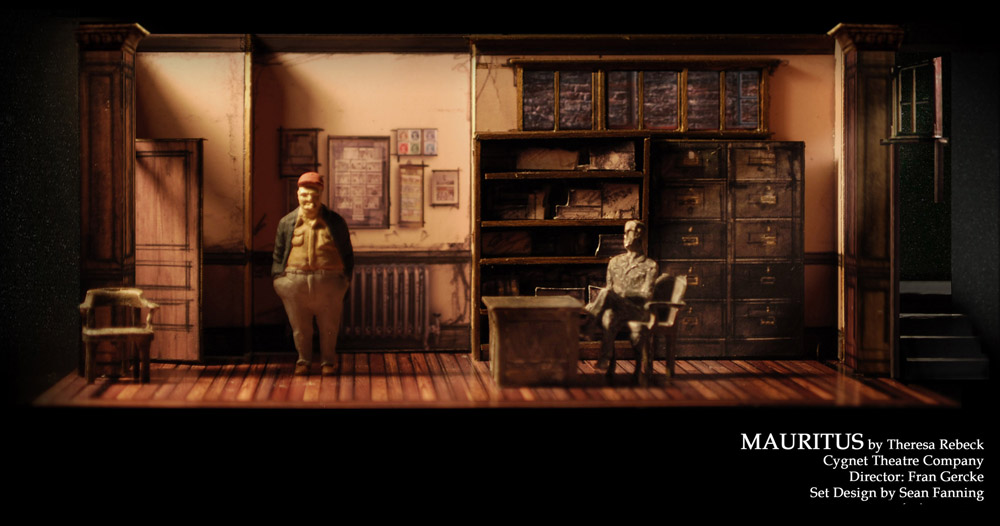
One of the challenges with Theresa Rebeck’s Mauritius is that it floats between three different environments. Not odd or uncommon or unusual in theatre. But normally it always leads designers, directors, and everyone else involved to ask: “Okay, how do we do this?” So then you start brainstorming and come up with a few great ideas, a couple of good ones, and several that lead to kind of uncomfortable silence (those ideas, unfortunately, normally emanate from me!). Mauritius has to move from a seedy, basement-level stamp shop to a street cafe to the parlor floor of a brown stone and back again. Sean Fanning’s set allows the actors to enter from the world above down into the stamp shop – the world below. And then this combatively comic world of philately simply, easily, and fluidly becomes a worn but still somehow elegant family home. And I am considerable jealous of the cast that gets to play in this environment because there is a great attention to deliberate detail.
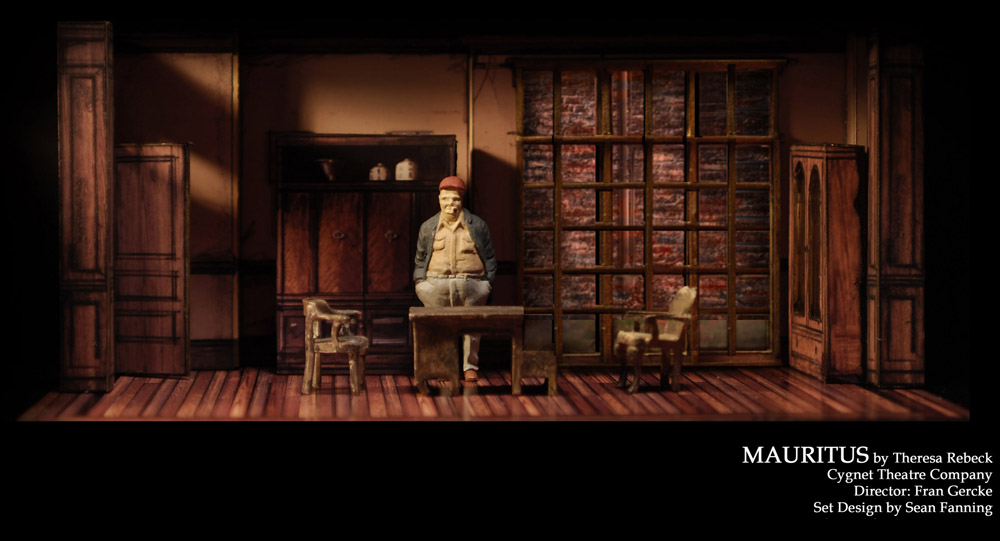
In the process of design, it’s always curious to me how you can run the risk of going too far. You can add too much “reality”. Sean Murray was wise to advise that you can go too far and open a kind of Pandora’s Box in which nothing is left to the imagination, everything is real, and what once was going to be a partnership between the suggested reality of the designer and imagination of the audience is no longer possible. I think we’ve avoided that, I think Sean Fanning has avoided that. Instead what he has created is very deliberate, very precise, very beautiful and still leaves much to the imagination….Now all we have to do is add the lights, the sound, the costumes, the props, learn our lines and not bump into anything!
